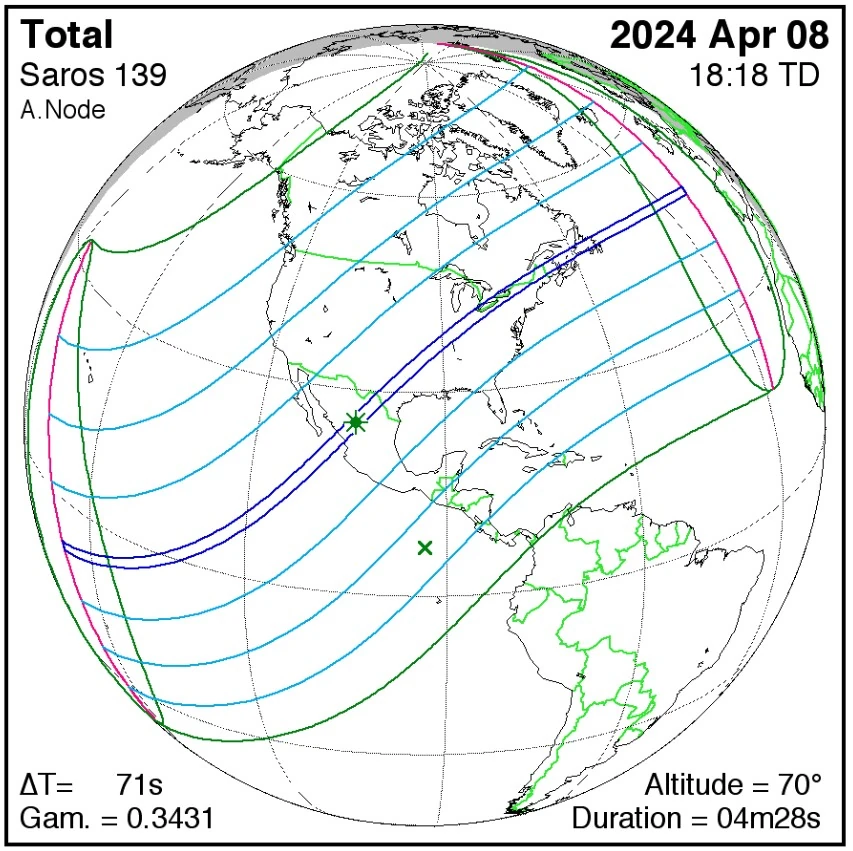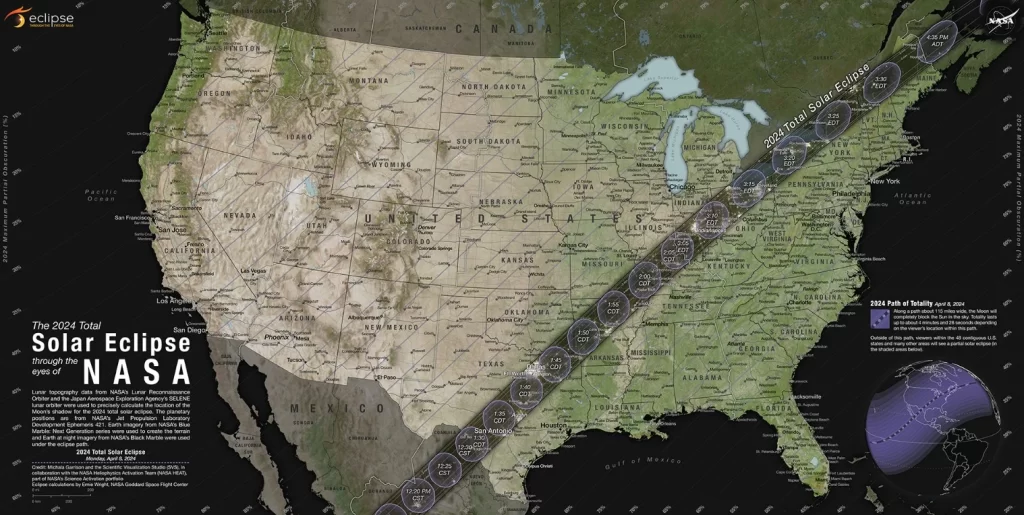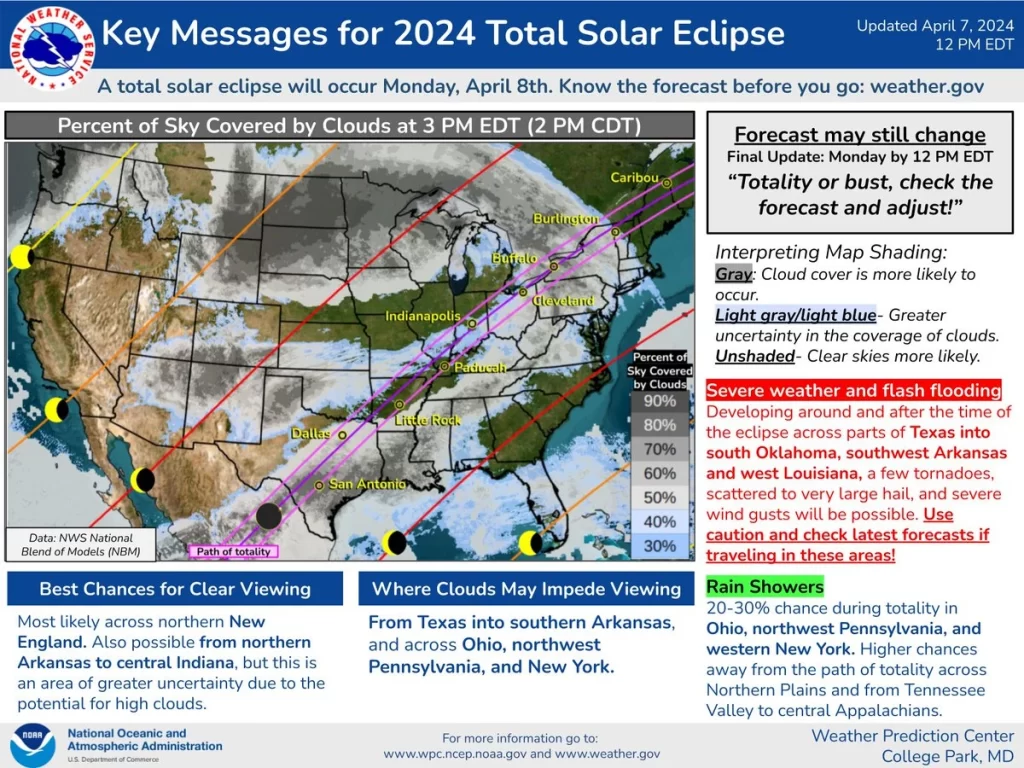A total solar eclipse dubbed the Great North American Eclipse will occur on Monday, April 8, 2024, and be visible from parts of Mexico, the United States, and Canada. This is the first time a total eclipse of the Sun will be visible from the contiguous United States since 2017.
The instant of the greatest eclipse will take place at 18:17 UTC – one day after the Moon reaches perigee. During the eclipse, the Sun will be in the constellation of Pisces. The synodic month in which it takes place has a Brown Lunation Number of 1253.
As explained by NASA’s Fred Espenak, this eclipse belongs to Saros 139 and is number 30 of 71 eclipses in the series. All eclipses in this series occur at the Moon’s ascending node. The Moon moves southward with respect to the node with each succeeding eclipse in the series and gamma decreases.
This will be a relatively long total eclipse with the greatest eclipse duration of 4 minutes and 28 seconds — with an eclipse magnitude of 1.0566.
The eclipse will enter continental North America in Mazatlan, Mexico, at 18:07 UTC (11:07 LT) and exit the continent in Newfoundland, Canada, at 19:46 UTC.
Residents and tourists in the United States will see the eclipse enter the state of Texas at 13:27 LT and exit in Maine at 15:35 LT (19:35 UTC).



The NWS Weather Prediction Center has updated its key messages for the total solar eclipse and cloud cover forecast on April 7. While high clouds spanning across parts of the totality path are likely, they may not completely obscure the eclipse.
The best chances for clear viewing are most likely across northern New England but are also possible from northern Arkansas to central Indiana. The latter, however, is an area of greater uncertainty due to the potential for high clouds.
The clouds will most certainly impede viewing from Texas into southern Arkansas and across Ohio, northwest Pennsylvania, and New York.


The following table provides the time that totality begins in some U.S. cities in the path of totality. Note that these areas will also experience a partial eclipse before and after these times.
| Location | Partial Begins | Totality Begins | Maximum | Totality Ends | Partial Ends |
|---|---|---|---|---|---|
| Dallas, Texas | 12:23 p.m. CDT | 1:40 p.m. CDT | 1:42 p.m. CDT | 1:44 p.m. CDT | 3:02 p.m. CDT |
| Idabel, Oklahoma | 12:28 p.m. CDT | 1:45 p.m. CDT | 1:47 p.m. CDT | 1:49 p.m. CDT | 3:06 p.m. CDT |
| Little Rock, Arkansas | 12:33 p.m. CDT | 1:51 p.m. CDT | 1:52 p.m. CDT | 1:54 p.m. CDT | 3:11 p.m. CDT |
| Poplar Bluff, Missouri | 12:39 p.m. CDT | 1:56 p.m. CDT | 1:56 p.m. CDT | 2:00 p.m. CDT | 3:15 p.m. CDT |
| Paducah, Kentucky | 12:42 p.m. CDT | 2:00 p.m. CDT | 2:01 p.m. CDT | 2:02 p.m. CDT | 3:18 p.m. CDT |
| Carbondale, Illinois | 12:42 p.m. CDT | 1:59 p.m. CDT | 2:01 p.m. CDT | 2:03 p.m. CDT | 3:18 p.m. CDT |
| Evansville, Indiana | 12:45 p.m. CDT | 2:02 p.m. CDT | 2:04 p.m. CDT | 2:05 p.m. CDT | 3:20 p.m. CDT |
| Cleveland, Ohio | 1:59 p.m. EDT | 3:13 p.m. EDT | 3:15 p.m. EDT | 3:17 p.m. EDT | 4:29 p.m. EDT |
| Erie, Pennsylvania | 2:02 p.m. EDT | 3:16 p.m. EDT | 3:18 p.m. EDT | 3:20 p.m. EDT | 4:30 p.m. EDT |
| Buffalo, New York | 2:04 p.m. EDT | 3:18 p.m. EDT | 3:20 p.m. EDT | 3:22 p.m. EDT | 4:32 p.m. EDT |
| Burlington, Vermont | 2:14 p.m. EDT | 3:26 p.m. EDT | 3:27 p.m. EDT | 3:29 p.m. EDT | 4:37 p.m. EDT |
| Lancaster, New Hampshire | 2:16 p.m. EDT | 3:27 p.m. EDT | 3:29 p.m. EDT | 3:30 p.m. EDT | 4:38 p.m. EDT |
| Caribou, Maine | 2:22 p.m. EDT | 3:32 p.m. EDT | 3:33 p.m. EDT | 3:34 p.m. EDT | 4:40 p.m. EDT |
Live view of the solar eclipse
Live views of the April 8, 2024 solar eclipse, will be available in the following video — starting at 17:00 UTC. The broadcast will include conversations with experts and provide telescope views from several sites across the eclipse path.
Featured image credit: NASA
Total solar eclipse of December 4, 2021
Wednesday, December 1, 2021
Total solar eclipse of December 14, 2020
Wednesday, December 9, 2020
Total Solar Eclipse of July 2, 2019
Monday, July 1, 2019
Total solar eclipse of August 21, 2017
Monday, August 21, 2017
Night sky guide for August 2017
Tuesday, August 1, 2017
Total solar eclipse of March 9, 2016 – best totality videos
Wednesday, March 9, 2016
Watch 2016 total solar eclipse live
Tuesday, March 8, 2016
